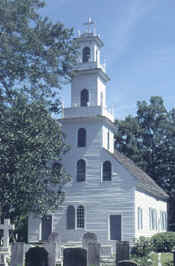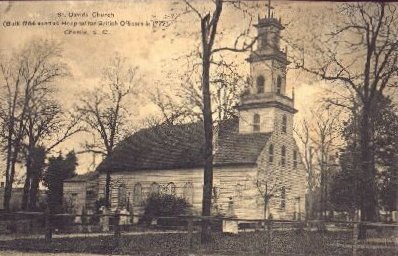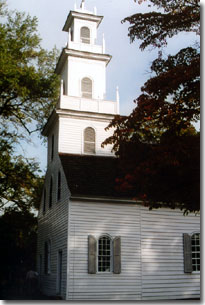


Navigation / Home / Family History / DNA Project / Photos / Stories / Gravestones / Back to Generation 4
St. David's Episcopal Church, Cheraw, Chesterfield County, South Carolina



St. David's Anglican Church - 1772
In 1768 by an act of the General Assembly of the Province of South Carolina, St. David's Parish was established to serve both the religious and civic needs of a growing population. The parish included the lands that later became Chesterfield, Marlboro, and Darlington Counties and portions of Florence and Lee.
During the colonial period, the Anglican Church was the established church in South Carolina, and the Vestry was as much a political body as a religious one. The wardens and commissioners were responsible for the roads, the poor, orphans, voting and collecting taxes in addition to their church duties.
This last parish to be established under King George III was named for David, patron saint of Wales. The first major Settlement in the Old Cheraws was the Welsh one near present day Society Hill, and the "Welsh Neck" made up a large portion of the new parish.
On February 22, 1770 the Commissioners contracted the building of a church with Thomas Bingham, carpenter. The building was to be located on the southwest side of the Pee Dee River on land granted for that purpose by Ely Kershaw, who owned most of what is now the downtown area of Cheraw. The church was in use by 1772, but was not actually completed until 1774.
During the Revolution, St. Davids was used by the South Carolina militia as quarters on several occasions, and in the summer of 1780, the 71st Highlanders (British) also used the church for quarters and a hospital. The Highlanders were a regiment of Lord Cornwallis' Army under the command of Colonel Campbell. A number of them became ill, probably with small pox, died and are buried in an unmarked mass grave at the front of the church. The officers were buried individually in graves covered by brick mounds.
During the War Between the States, Old St. David's was used as a hospital by both armies. There are two drawings showing the church with rows of tents among the graves. The church was slightly damaged in the munitions explosion that destroyed most of the business area at that time. Blood stains can still be seen upon the floor when the carpets are lifted. A large number of Confederate dead are buried in the cemetery, and in their midst stands the first monument ever erected in memory of the soldiers of the South, an impressive granite shaft.
Buried in the graveyard are veterans of seven wars. Among the most noted graves are those of Bishop Alexander Gregg, historian and first Episcopal bishop of Texas, Captain Moses Rogers, commanding officer of the Savannah, first steamer to cross the Atlantic, and Dr. Cornelius Kollock, president of the American Medical Society. Here lies also the body of H. E. Godfrey, who was for sixty three years the organist of the church.
Minutes of the Vestry
April 1768: The following gentlemen were named Commissioners for the Parish of St. David's: Claudius Pegues Charles Bedingfield Philip Pledger James James Alexander Mackintosh Robert Weaver George Hicks James Thomson Thomas Ellerbee Thomas Crawford Robert Alison Thomas Porte Thomas Lide Benjamin Rogers August 1st 1768: The Commissioners met at the House of Mr. Charles Bedingfield. Absent were Thomas Ellerbee, Robert Weaver, James Thomson, Thomas Crawford and Thomas Porte. Declining to act as Commissioners were Alexander Mackintosh, James James and Robert Alison. Elections were held. Elected as Vestry Men: Claudius Pegues, Philip Pledger, William Godfrey, Charles Bedingfield, Thomas Lide, Thomas Ellerbee, Thomas Bingham Elected as Church Wardens: Alexander Gordon and Benjamin Rogers. Durham Hitts was appointed Clerk of the Vestry. Electors were: William Hardwick Duke Glen John Mackintosh John Jenkins Edward Ellerbee John Husbands Thomas Boatright, Senr. Jesse Counsell John Pledger Robert Clary Robert Anderson Benjamin Jackson James Knight Samuel Wise James Thursby Thomas Williams Thomas Wade Leonard Dozier
last modified: February 5, 2006
URL: http://www.boatwrightgenealogy.com
Navigation / Home / Family History / DNA Project / Photos / Stories / Gravestones / Back to Generation 4